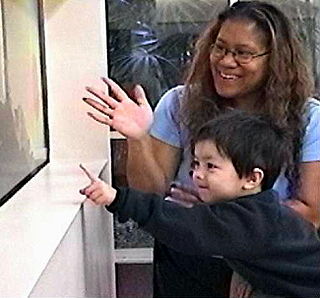
Asperger syndrome (AS), also known as Asperger's syndrome, formerly described a neurodevelopmental disorder characterized by significant difficulties in social interaction and nonverbal communication, along with restricted and repetitive patterns of behavior, interests, and activities. The syndrome has been merged with other disorders into autism spectrum disorder (ASD) and is no longer considered a stand-alone diagnosis. It was considered milder than other diagnoses that were merged into ASD by relatively unimpaired spoken language and intelligence.
The diagnostic category pervasive developmental disorders (PDD), as opposed to specific developmental disorders (SDD), was a group of disorders characterized by delays in the development of multiple basic functions including socialization and communication. It was defined by the Diagnostic and Statistical Manual of Mental Disorders (DSM), and the International Classification of Diseases (ICD).

Occupational therapy (OT) is a healthcare profession that involves the use of assessment and intervention to develop, recover, or maintain the meaningful activities, or occupations, of individuals, groups, or communities. The field of OT consists of health care practitioners trained and educated to improve mental and physical performance. Occupational therapists specialize in teaching, educating, and supporting participation in any activity that occupies an individual's time. It is an independent health profession sometimes categorized as an allied health profession and consists of occupational therapists (OTs) and occupational therapy assistants (OTAs). While OTs and OTAs have different roles, they both work with people who want to improve their mental and or physical health, disabilities, injuries, or impairments.
Relationship Development Intervention (RDI) is a trademarked proprietary treatment program for autism spectrum disorders (ASD), based on the belief that the development of dynamic intelligence is the key to improving the quality of life for autistic people. The program's core philosophy is that autistic people can participate in authentic emotional relationships if they are exposed to them in a gradual, systematic way. The goal of treatment is to systematically build up the motivation and tools for successfully interacting in social relationships, to correct deficits in this area that are thought to be common to all autistic people.
Developmental disorders comprise a group of psychiatric conditions originating in childhood that involve serious impairment in different areas. There are several ways of using this term. The most narrow concept is used in the category "Specific Disorders of Psychological Development" in the ICD-10. These disorders comprise developmental language disorder, learning disorders, motor disorders, and autism spectrum disorders. In broader definitions ADHD is included, and the term used is neurodevelopmental disorders. Yet others include antisocial behavior and schizophrenia that begins in childhood and continues through life. However, these two latter conditions are not as stable as the other developmental disorders, and there is not the same evidence of a shared genetic liability.
Attachment disorder is a broad term intended to describe disorders of mood, behavior, and social relationships arising from unavailability of normal socializing care and attention from primary care giving figures in early childhood. Such a failure would result from unusual early experiences of neglect, abuse, abrupt separation from caregivers between three months and three years of age, frequent change or excessive numbers of caregivers, or lack of caregiver responsiveness to child communicative efforts resulting in a lack of basic trust. A problematic history of social relationships occurring after about age three may be distressing to a child, but does not result in attachment disorder.
Reactive attachment disorder (RAD) is described in clinical literature as a severe disorder that can affect children, although these issues do occasionally persist into adulthood. RAD is characterized by markedly disturbed and developmentally inappropriate ways of relating socially in most contexts. It can take the form of a persistent failure to initiate or respond to most social interactions in a developmentally appropriate way—known as the "inhibited form". In the DSM-5, the "disinhibited form" is considered a separate diagnosis named "disinhibited attachment disorder".
Stanley Greenspan was an American child psychiatrist and clinical professor of Psychiatry, Behavioral Science, and Pediatrics at George Washington University Medical School. He was best known for developing the floortime approach for attempting to treat children with autistic spectrum disorders and developmental disabilities.
Reading for special needs has become an area of interest as the understanding of reading has improved. Teaching children with special needs how to read was not historically pursued due to perspectives of a Reading Readiness model. This model assumes that a reader must learn to read in a hierarchical manner such that one skill must be mastered before learning the next skill. This approach often led to teaching sub-skills of reading in a decontextualized manner. This style of teaching made it difficult for children to master these early skills, and as a result, did not advance to more advanced literacy instruction and often continued to receive age-inappropriate instruction.
The following outline is provided as an overview of and topical guide to autism:

Autism therapies include a wide variety of therapies that help people with autism, or their families. Such methods of therapy seek to aid autistic people in dealing with difficulties and increase their functional independence.
Dyadic developmental psychotherapy is a psychotherapeutic treatment method for families that have children with symptoms of emotional disorders, including complex trauma and disorders of attachment. It was originally developed by Arthur Becker-Weidman and Daniel Hughes as an intervention for children whose emotional distress resulted from earlier separation from familiar caregivers. Hughes cites attachment theory and particularly the work of John Bowlby as theoretical motivations for dyadic developmental psychotherapy.

Classic autism, also known as childhood autism, autistic disorder, (early) infantile autism, infantile psychosis, Kanner's autism,Kanner's syndrome, or (formerly) just autism, is a neurodevelopmental condition first described by Leo Kanner in 1943. It is characterized by atypical and impaired development in social interaction and communication as well as restricted, repetitive behaviors, activities, and interests. These symptoms first appear in early childhood and persist throughout life.

Autism, formally called autism spectrum disorder (ASD) or autism spectrum condition (ASC), is a neurodevelopmental disorder marked by deficits in reciprocal social communication and the presence of restricted and repetitive patterns of behavior. Other common signs include difficulty with social interaction, verbal and nonverbal communication, along with perseverative interests, stereotypic body movements, rigid routines, and hyper- or hyporeactivity to sensory input. Autism is clinically regarded as a spectrum disorder, meaning that it can manifest very differently in each person. For example, some are nonspeaking, while others have proficient spoken language. Because of this, there is wide variation in the support needs of people across the autism spectrum.

Rebecca School is an independent private day school in New York City that specializes in teaching children ages four to twenty-one who have a range of neurodevelopmental disorders, including autism spectrum disorder (ASD). The school was founded in 2006 and uses a special teaching method known as Floortime/DIR developed by Stanley Greenspan, M.D., a child psychiatrist and specialist in autism education who died in 2010. Greenspan's method was a change from the more traditional methods that sought to change behavior through conditioning using rewards and punishments. His method focuses on children's ability to build relationships. Rebecca School's space and facilities on East 30th Street were specially designed for the needs of autistic and special needs children, based on Dr. Greenspan's ideas. The school utilizes not only teachers who are trained to work with special needs students, but also social workers who work with the families of the students.
A late talker is a toddler experiencing late language emergence (LLE), which can also be an early or secondary sign of an autism spectrum disorder, or other developmental disorders, such as fetal alcohol spectrum disorder, attention deficit hyperactivity disorder, intellectual disability, learning disability, social communication disorder, or specific language impairment. Lack of language development, comprehension skills, and challenges with literacy skills are potential risks as late talkers age. Outlook for late talkers with or without intervention is generally favorable. Toddlers have a high probability of catching up to typical toddlers if early language interventions are put in place. Language interventions include general language stimulation, focused language stimulation and milieu teaching.

Sensory processing disorder is a condition in which multisensory input is not adequately processed in order to provide appropriate responses to the demands of the environment. Sensory processing disorder is present in many people with dyspraxia, autism spectrum disorder and attention deficit hyperactivity disorder. Individuals with SPD may inadequately process visual, auditory, olfactory (smell), gustatory (taste), tactile (touch), vestibular (balance), proprioception, and interoception sensory stimuli.
Daniel Messinger is an American interdisciplinary developmental psychologist, and academic. His research works span the field of developmental psychology with a focus on emotional and social development of children and infants, and the interactive behavior of children in preschool inclusive classroom.
The Early Start Denver Model (ESDM) is a form of intervention directed at young children that display early signs of being on the autism spectrum proposed by American psychiatrists Sally J. Rogers and Geraldine Dawson. It is intended to help children improve development traits as early as possible so as to narrow or close the gaps in capabilities between the individual and their peers.
The diagnosis of autism is based on a person's reported and directly observed behavior. There are no known biomarkers for autism spectrum conditions that allow for a conclusive diagnosis.







